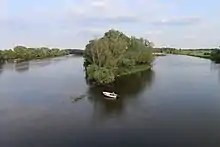Warta
The river Warta (/ˈvɑːrtə/ VAR-tə, Polish: [ˈvarta] ⓘ; German: Warthe [ˈvaʁtə] ⓘ; Latin: Varta) rises in central Poland and meanders greatly north-west to flow into the Oder, against the German border. About 808.2 kilometres (502.2 mi) long, it is Poland's second-longest river within its borders after the Vistula, and third-longest including the Oder, that flows also across Czech Republic and Germany.[1] Its drainage basin covers 54,529 square kilometers (21,054 sq mi)[1] and it is navigable from Kostrzyn nad Odrą to Konin, approximately half of its length.[2] It is connected to the Vistula by the Noteć and the Bydgoszcz Canal (Kanał Bydgoski) near the city of Bydgoszcz.
| Warta | |
|---|---|
 Warta River near Wronki | |
.png.webp) | |
| Location | |
| Country | Poland |
| Physical characteristics | |
| Source | |
| • location | Kromołów, part of Zawiercie, Kraków-Częstochowa Upland |
| • elevation | 380 m (1,250 ft) |
| Mouth | |
• location | Oder River at Kostrzyn |
• coordinates | 52.5986°N 14.6103°E |
| Length | 808.2 km (502.2 mi) |
| Basin size | 54,529 km2 (21,054 sq mi) |
| Discharge | |
| • average | 195 m3/s (6,900 cu ft/s) |
| Basin features | |
| Progression | Oder→ Baltic Sea |
Course
The Warta rises in the Kraków-Częstochowa Upland at Kromołów in Zawiercie, Silesian Voivodeship, flows through Łódź Land, Greater Poland and Lubusz Land, where it empties into the Oder near Kostrzyn at the border with Germany.
The Greater Warta Basin defines the site of early Poland; it is said that the tribe of Western Polans (Polish: Polanie) settled the Warta Basin between the 6th and 8th century. The river is also mentioned in the second stanza of the Polish national anthem, "Poland Is Not Yet Lost".
Major cities
- Zawiercie
- Myszków
- Częstochowa
- Mstów
- Działoszyn
- Sieradz
- Warta
- Uniejów
- Koło
- Konin
- Pyzdry
- Śrem
- Mosina
- Puszczykowo
- Luboń
- Poznań
- Oborniki
- Obrzycko
- Wronki
- Sieraków
- Międzychód
- Skwierzyna
- Gorzów Wielkopolski
- Kostrzyn nad Odrą



